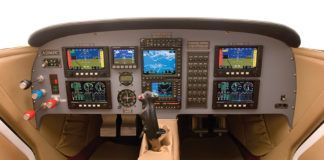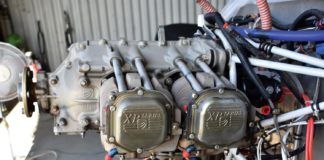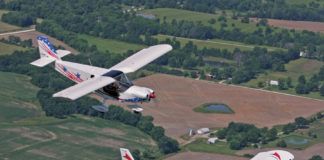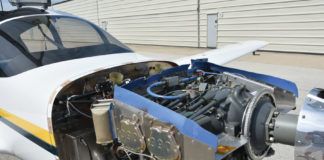When discussing airplanes, performance is the first thing we think about, and money is the second. We tend to talk in terms of speed, range, payload and cost. While all of these factors are important, it is easy to forget something that can be even more critical to the success of the airplane.
The flying qualities of an airplane are at least as important as its performance. This is especially true in the world of private aviation, where performance is less critical. A few knots of cruise speed or a few pounds of useful load may make the difference between commercial success or ruin for an airliner, or life and death for a military airplane. For a private operator they are not insignificant, but they are not make or break either.
Flying qualities have a large effect on both the desirability and safety of a general aviation airplane. A good airplane is both safe and enjoyable to fly. Most private pilots fly for recreation and personal transportation, and an airplane that is unpleasant to fly is unlikely to sell very well even if it has sparkling performance. More than one design has failed in the marketplace because of handling quirks that were not particularly dangerous, but were sufficiently unusual or undesirable to ruin the reputation of the type.
Poor flying qualities can also have a significant impact on the safety of the airplane. For the airplane to be satisfactory, the pilot must be able to keep it under control while performing any maneuver the airplane is designed to be capable of. If the airplane is difficult to control, or if the pilots workload becomes too high in adverse conditions, the airplane may be too dangerous to operate in part of the flight envelope.
Flying qualities are the subject of periodic controversies in the homebuilt and kit airplane world. Homebuilts are not required to meet any regulatory standards, so what is acceptable is in essence defined by what the manufacturers are willing to produce, and what their customers are willing to accept. Accordingly, there is a tendency to defend designs based on the idea that customers like their airplanes. While this has some validity, the accepted standards for fl ying qualities are the result of extensive research and experience. Despite the lack of official standards, the real needs of the pilot still impose some requirements on how the airplane flies. In particular, the airplane must be airworthy and safe to fly regardless of its mission or the regulatory environment in which it operates.
Tasks
When we consider flying qualities, it is important to realize that the characteristics of the airplane must be evaluated in terms of the pilots ability to perform specific tasks. The demands made on the pilot to perform each task are different, so an evaluation is only meaningful in the context of the task being performed. This is particularly important because an airplane that is completely satisfactory for one task might be dangerously unacceptable elsewhere in its flight envelope.
Every designer faces the challenge of giving the airplane flying qualities that are acceptable for all of the maneuvers and flight conditions that will be required of the airplane. This can be challenging because the requirements of some tasks are opposite to those of other tasks. For example, for hard maneuvering, low elevator stick force and relatively small pitch stability margins are desirable. On the other hand, for flying an instrument approach we want the airplane to be very stable and well-damped in pitch. An airplane that is fun to fly in clear, calm VFR conditions can become a real handful in turbulent, IFR conditions, and an airplane that makes a good instrument platform is likely to be seen as flying like a truck when flown for recreation on a clear day.
Another factor that demands the designers attention is that some tasks are performed only rarely, but can be safety critical when they are. Some examples of such tasks are evasive maneuvering to avoid an obstacle or midair, missed approaches, and slipping on final to try to salvage a high/hot approach. The airplane might be entirely satisfactory most of the time and yet become unsatisfactory in one of these situations. This is particularly concerning because these rare situations are the ones that pilots are less likely to be experienced with, and accordingly they may be less able to compensate for handling difficulties with the airplane.
One example of such an issue from the certified airplane world is the characteristics of the venerable Cessna 150 during a missed approach at full flaps. The 150 with full flaps had a very large nose-up pitching moment when full power was applied to go around. In a gross-weight go-around the pilot was faced with a situation where the airplane required a large push force on the yoke to keep it from stalling, combined with a high drag condition that led to very slow acceleration. Performing a go-around required the pilot to maintain large stick force while controlling airspeed accurately until the airplane had gained enough airspeed for the pilot to safely start retracting the flaps. As the flaps came up, there was a significant trim change the pilot had to compensate for.
While many pilots learned how to fly in this airplane, and many thousands of them are still in service, Cessna decided that the improvement in landing performance generated by the last 10 of flap deflection was not enough to justify the flying qualities issue. Later models, including the successor 152s, had the flaps limited to 30 deflection instead of the 40 available in earlier 150s. Interestingly, this flying qualities issue involved control forces that were considered to be too high, rather than too low, as is often the case with kit and homebuilt airplanes.
Response Factors
The flying qualities of the airplane are determined by how the airplane responds to perturbations from both the atmosphere and control inputs made by the pilot. This response is affected by a mix of a large number of factors related to the characteristics of the basic airframe and its control system.
Stability and Damping
The response of the airframe to changes in angle of attack or sideslip defines its basic stability. A stable airplane will tend to return to its original flight condition without control inputs. The more stable the airplane is, the more it will tend to stay at its trimmed flight condition and resist the effects of atmospheric perturbations (gusts) and control inputs that try to change it. While it is desirable for all manually controlled airplanes to be somewhat stable, the most desirable level of stability, particularly in pitch and roll, varies quite a bit depending on the task the airplane must perform.
Damping is another open loop (no control inputs) characteristic of the airframe that affects flying qualities. Damping is the tendency for a rate (pitch, roll or yaw) to die out. When a stable airplane is perturbed in pitch or yaw, the initial response will be for the airplane to develop a rate that drives it back towards its initial flight condition. When the airplane gets to its original trimmed angle of attack or sideslip angle it will still have a pitch or yaw rate, and it will overshoot the trimmed condition. This will cause a moment that drives the airplane back the other way, and the process repeats, leading to an oscillation. If the airplane is well damped, this oscillation will die out quickly. If it is not, the airplane may continue to oscillate for several cycles.
Damping is of particular concern in the lateral/directional axes because of a coupled roll/yaw mode known as Dutch roll. To the occupants of the airplane a Dutch roll oscillation feels like a tail wag or wallowing. Yaw damping is a particularly large player in damping this mode. Dutch roll damping is another good example of the designers dilemma. If we want the airplane to be spirally stable so that it will continue to fly straight rather than tapering off into a spiral when the pilot releases the controls, the airplane needs relatively high dihedral effect and less weathercock stability. Unfortunately, both of these factors tend to reduce the damping of the Dutch roll mode and make the airplane wallow in turbulence. Spiral stability might appear desirable at first for instrument flying since it reduces pilot workload to hold heading, but poor Dutch roll damping will increase the pilots workload as he tries to compensate and keep the airplane from oscillating.
Trim
We have already alluded to trim issues in our discussion of the Cessna 150 missed approach. Ideally, in steady-state flight, the pilot should not have to exert any constant control pressure to keep the airplane at the desired flight condition. If this is not possible, the control force required to trim the airplane should be light enough that the pilot can continue to hold the required control pressure for far longer than the minimum time required to be safe. A good example of such a situation would be the steady rudder pressure required to keep the ball centered in climb on most single-engine airplanes. Because these airplanes lack adjustable rudder trim, they are set up to require zero rudder force in cruise. Accordingly, the pilot must hold some rudder pressure at low airspeed and high power to compensate for torque and P-factor.
It is highly undesirable to have an airplane that cannot be trimmed to zero control force in a steady state cruise or landing approach. The need to hold constant control pressure is tiring. It can also lead to difficulty controlling the airplane in a high-workload situation. If the pilots attention is taken by navigating, communicating, adjusting radios or a navigation system, his attention will be diverted from controlling altitude, airspeed and heading. If the airplane is in trim, a brief distraction will not lead to any large changes in flight path. However, if the airplane is out of trim, it will start to pitch, roll or yaw (depending on the out-of-trim axis) as soon as the distracted pilot relaxes the pressure effective, the airplane may be very sensitive to pilot inputs. This can lead to several problems including pilot-induced oscillations (PIO). Overly powerful controls may also make it too easy for the pilot to overstress the airplane.
Control Forces
To deflect the control surfaces, the pilot must pull or push on the cockpit controls. The amount of force required to deflect the controls, or to hold them in position, are the primary source of feedback the pilot uses in controlling the airplane. The magnitude of on the controls. This will be a significant annoyance at best, and can be a factor in loss of control of the airplane in worst cases.
Another factor that we have already touched on is the magnitude of the control force the pilot must exert to keep the airplane trimmed as the flight condition changes. Rapid trim changes that require large pilot control force inputs to maintain control are highly undesirable.
Control Power
In order to trim and maneuver the airplane, the pilot must have a way to generate moments about all three axes (pitch, roll and yaw) of the airplane. This is the function of the elevators, ailerons and rudder. The amount of control power these surfaces can generate is a major factor in determining the flying qualities of the airplane. If the control surfaces cannot generate large enough moments, the pilot may not be able to trim the airplane or command a maneuver without driving a control to the stop.
Too much control power can also be an issue. If the controls are too these forces and the way they vary with control deflection, airspeed and load factor (G-load) are critical to how easy the airplane is to control.
The relative magnitude of the control forces required for each axis is also important. This relationship between elevator, rudder and aileron forces is called control harmony. For good flying qualities, the forces must be well matched. If the airplane requires large forces in one axis and light forces in another, it is difficult for the pilot to maintain delicate control over the light-force axis while simultaneously exerting a lot of force to control the other axis.
A large part of the job of the designer is tailoring these control forces. As we will see in future articles, these control forces are important players in determining the flying qualities of the airplane.
Good flying qualities are a vital part of a good airplane. If the airplane is easy to fly, the pilot will find flying it to be an enjoyable and safe experience. If not, problems ensue. In the next few months we will look in more detail at some critical aspects of flying qualities.













